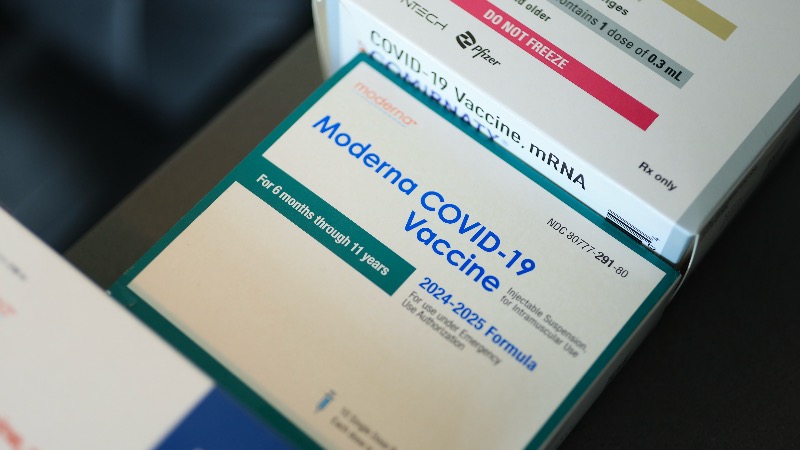 Image Credit: Joe Raedle / Staff / Getty
Image Credit: Joe Raedle / Staff / Getty The Centers for Disease Control and Prevention’s (CDC) COVID-19 vaccine work group today assured the agency’s new panel of vaccine advisers that the vaccines are necessary, effective and have no safety concerns beyond a small risk of myocarditis among an age-limited group of young men.
The new members of the Advisory Committee on Immunization Practices (ACIP) pushed back on several claims made by the presenters, including the agency’s methods for assessing efficacy and safety.
They also questioned claims the group made about how dangerous the COVID-19 virus is, especially for children.
ACIP didn’t schedule a vote today on COVID-19 vaccines. The committee only heard data presentations by the work group and engaged in a question-and-answer session.
Today’s meeting was the first since U.S. Health and Human Services Secretary Robert F. Kennedy Jr. fired the previous 17 ACIP members and replaced them with eight (now seven) new members.
The work group members haven’t changed under the new administration.
Last month, Kennedy announced changes to the COVID-19 vaccination recommendations for children and pregnant women.
The CDC now recommends “shared clinical decision-making” between parents and providers for healthy children ages 6 months to 17 years who are not moderately immunocompromised. The agency changed its guidance on COVID-19 vaccines for pregnant women from recommended to “no guidance.”
After several hours of presentations, the work group concluded that the 2024-2025 vaccines were effective in preventing hospitalizations and critical outcomes from COVID-19 in adults, that there is robust safety surveillance with no known risks beyond myocarditis.
The group also concluded that pregnant women are at greater risk from COVID-19, and that maternal vaccination has been shown to protect infants — a claim unsupported by any data from the presentations, said Dr. Meryl Nass, who live-blogged the meeting for CHD.TV.
How deadly is COVID?
The CDC’s Dr. Adam MacNeil introduced the session on COVID-19 vaccines and presented data on COVID-19 epidemiology, and vaccine effectiveness and safety.
MacNeil reported that most COVID-19-associated hospitalizations happen among adults 75 and older, followed by adults ages 65-74 and infants under 6 months.
The total number of reported deaths with COVID-19 between July 2024 and June 2025 included 45 deaths in children under age 2, 16 deaths among children 2-4 years old and 29 among children ages 5-17.
The largest number of reported deaths, 16,375, occurred among people 75 and older. All of those numbers have decreased steadily since 2020.
Death certificate data from across the U.S. showed 20,800 total deaths from COVID-19 from October 2024 to May 2025. However, MacNeil said that death certificates likely underestimated deaths, and models showed there were likely 32,000-51,000 deaths.
Nass said MacNeil’s presentation appeared to be dedicated to making the case that healthy children are at high risk for COVID-19, which “flies in the face of almost everything else we have learned.”
Deaths continue to occur among infants and “death certificate data may continue to undercount these,” MacNeil said, adding that 89% of vaccine-eligible children and adolescents had no record of being vaccinated.
ACIP members question CDC methodologies
During the first round of questions and answers, ACIP committee co-chair Martin Kulldorff, Ph.D., raised concerns that none of the data presented by the CDC work group came from randomized placebo-controlled trials, and that the observational studies did not use more rigorous case-controlled studies, but instead used test-negative studies, which can introduce more bias.
ACIP member Dr. H. Cody Meissner asked whether the hospitalization and death rates for COVID-19 were for people who were hospitalized or died because they were severely ill with COVID-19 or whether they simply had a positive PCR test.
“I think you said that 50% of the pregnant women who were hospitalized had signs and symptoms of a respiratory infection,” Meissner said. “So I interpret that to mean the other 50% did not have signs and symptoms and were therefore colonized, if that’s the right word, with the coronavirus.”
The CDC subject matter expert conceded that the data were linked to positive tests, not to illness from COVID-19, but said the percentages of people who have positive tests are lower now because everyone admitted to the hospital is not necessarily automatically tested, as was the case during the pandemic.
Meissner also clarified that the hospitalization rates for children were actually very low — less than 1 per 100,000 for children under age 4. “My point is that this is a very rare illness in young children, as well as in adults,” he said.
MacNeil countered that although the numbers he presented are admittedly low, cumulatively, there has been a lot of severe COVID-19 illness among children.
ACIP member Retsef Levi, Ph.D., questioned the CDC’s interpretation of its own efficacy data. He noted that the elderly population hospitalized with COVID-19 had higher vaccination rates than the general population.
He said a different interpretation of the same data could be that the COVID-19 vaccine makes people more vulnerable to multiple viruses. Kulldorff said such a lack of clarity was inherent in the “test negative” methodology they were using.
Dr. Tracy Beth Høeg, an ex-officio ACIP committee member from the U.S. Food and Drug Administration, said she shared the concern that there were no randomized controlled study data. She said she wanted to see such trials to reduce biases present in the existing methods, “So we aren’t sitting here wondering, are we being misled by these data?”
CDC: ‘No risk of mortality after COVID-19 vaccines’
Dr. Sarah Meyer of the CDC told the committee the agency has analyzed at least 65 different safety outcomes using a variety of systems and epidemiologic methods.
From 2020-2025, they identified eight signals — acute myocardial infarction, immune thrombocytopenic purpura, seizure, Bell’s palsy, venous thromboembolism, ischemic stroke, Guillain-Barré syndrome and myocarditis, she said. Once they identify signals, the agency undertakes further investigation.
Upon further investigation, Meyer said they found only an increased risk for myocarditis. Rates peak at ages 16-17 and are higher in males. Myocarditis is rare in children under 12 and adults 50 or older, she reported.
She also said most reports to the Vaccine Adverse Events Reporting System (VAERS) involving children were related to vaccine administration errors.
To analyze effects on pregnant women, the work group analyzed the CDC’s COVID-19 pregnancy registry and data from the Vaccine Safety Datalink. Meyer said they found no increased risk for maternal outcomes, such as maternal intensive care unit (ICU) admission, for pregnancy, such as miscarriage or preterm birth, or for infant outcomes, such as major birth defects, ICU admission or infant death.
The CDC also studied abnormal uterine bleeding and found there was no association of the vaccines with a change in “medically attended” abnormal bleeding among women. They studied tinnitus and also found no increased risk of tinnitus.
Meyer said that as of May 30, there have been 19,417 U.S. deaths reported to VAERS and that the agency conducted an evaluation of those reports. They found no increased risk of death following mRNA COVID-19 vaccines.
To the contrary, she said, the vaccines have been found to have a protective effect. “There is no risk of mortality after COVID-19 vaccines. We feel confident in our data,” she said.
Nass noted that the methods the CDC used to analyze adverse events in this presentation were different than what they had previously reported. “Their methods deserve a great deal of scrutiny,” she wrote.
New ACIP member Dr. Robert Malone also called for more transparency in the methods used. He asked for the data on the other safety outcomes the work group had ruled out. He also raised concerns about the long-term presence of the spike protein.
COVID vaccine coverage is low
The final presentation showed that COVID-19 vaccine coverage is low.
Approximately 4.6% of children under age 4 were up to date on their COVID-19 vaccines at the time of analysis, and overall, approximately 13% of children ages 6 months to 17 years were up to date.
COVID-19 vaccination rates among adults remained steady, but also low — 23% for adults over 18, and less than 50% among adults 65 and older.
Meissner asked if people’s willingness to take a vaccine affected ACIP’s recommendation.
“My only concern is that if the CDC makes a recommendation that people simply are not going to follow, I mean, it’s troubling because people lose confidence in a recommendation then, I know there’s no easy answer to this, but I think it does need to be considered at some point,” he said.
Kulldorff said the recommendations have to be evidence-based, but that it was an important question, because the low rates, particularly among children, indicate that parents don’t trust the vaccine recommendations ACIP has made in the past.
FBI Confirms 2020 Election Theft!



